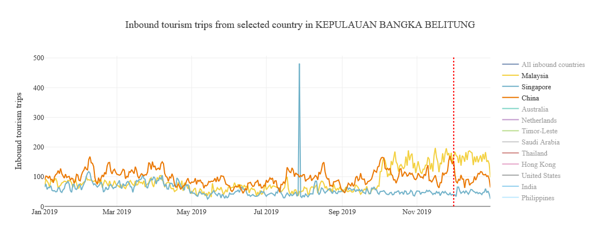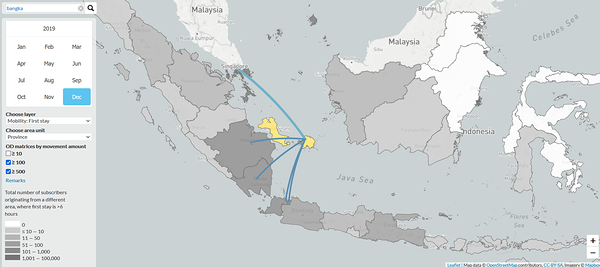Take, for example, the province of Bangka Belitung Islands. The province has emerged as one of the major tourist destinations in Indonesia because of the popularity of the movie Laskar Pelangi (The Rainbow Troops). The data published by the national statistics institute of Indonesia, Statistics Indonesia (locally known as BPS), shows that, after the central government instituted travel restrictions in March 2020, the number of visitors dropped by almost 90% compared to the same period the previous year. For example, in May 2020, only 2,720 visitors came to Bangka Belitung compared to 24,049 visitors in May 2019. With many of its areas continuously included in the green zone (no new cases or low transmission of COVID-19), by the end of 2020, the provincial government was already eager to revive the industry which has suffered significant downturns. Indeed, up until December 2020, the 31st province of Indonesia, located off the East Coast of Sumatra Island, consistently showed a lower rate of positive coronavirus cases relative to the other provinces in the country. However, this situation suddenly changed at the beginning of this year. The rising number of positive cases recently found in the Bangka Belitung Islands has forced the local authorities to halt their tourism campaigns and close some of the tourist destinations, thereby complicating the efforts to revive the industry.
MPD also offers a unique capability for monitoring the visitors’ mobility, which cannot be obtained using other traditional statistical sources.
There are three ways that MPD can help local authorities and key stakeholders in restarting the tourism industry. First, it provides a consistent data source in the situation where the production of traditional tourism statistics is limited. In restarting tourism in the Bangka Belitung Islands, the need for accurate, timely, and granular statistical data is of paramount importance to drive the decision-making process in designing interventions to reboot the industry. Yet, while demand is increasing, traditional ways of collecting tourism data have been proven and continue to be more challenging in the age of the COVID-19 pandemic due to health and safety reasons, limiting the supply of data. The latest tourism data available on BPS’s portal is only available up to May 2020. In this situation, MPD, based on an automatic collection of mobile subscribers’ location data, offers a better alternative to provide tourism statistics.
Secondly, MPD provides more granular data in time and scale, which could also help tourism authorities in making informed decisions, such as when promoting domestic tourism or establishing bilateral and regional travel bubbles. Unlike traditional survey data, MPD can be generated and accessed on a frequent basis, or even in near real-time, enabling monitoring the impact of policymaking in the short, medium, and long term. Similarly, MPD can provide continuous, longitudinal data series, allowing robust assessments of change over time.The figure above shows daily tourism data of inbound foreign visitors before the pandemic to Bangka Belitung islands from Malaysia, Singapore, and China, which are the top three inbound countries. Having the advantage of being geographically close to these countries means there is an opportunity for a quick recovery for Bangka Belitung tourism as the visitors tend to prioritise short-distance travel after the pandemic. The data also shows that the number of visitors tends to peak towards the end of the year, which means preparations need to be made quickly in order to safely welcome the inflow of foreign visitors into the area once the travel restriction has been eased. Moreover, unlike traditional data sources, the availability of daily visitor data enables local authorities to monitor weekend trends or mobility during specific events/festivals. For example, the above data from 2019 shows that the annual Toboali City On Fire tourism festival (26–28 July 2019) attracted quite a significant number of Singaporean visitors on its last day as it coincided with the weekend holiday.
Thirdly, MPD also offers a unique capability for monitoring the visitors’ mobility, which cannot be obtained using other traditional statistical sources. Understanding the mobility patterns is not only useful for tourism planning but also for preventing the spread of the virus. Foreign visitors might have either flown in directly to Bangka Belitung or come after having visited other cities in Indonesia. Data from December 2019 shows that visitors came to Bangka Belitung after visiting the Batam, Jakarta, Banten, South Sumatera and Lampung provinces. Such data helps the provincial government of Bangka Belitung Islands to better understand the mobility patterns of the visitors in order to work with other local governments to facilitate these journeys. The provincial government may also initiate preventive actions to limit visitors from certain cities depending on the current pandemic situation, for example from Jakarta, which has the highest number of positive cases in Indonesia.In summary, in order to understand the quickly changing world around us, both traditional and new big data sets, such as MPD, have to be combined. In the event of a crisis, governments need more frequent data to support handling of the situation. The use of MPD can help the government get useful statistical data in order to restart the tourism industry in a more responsible way.
.png)


